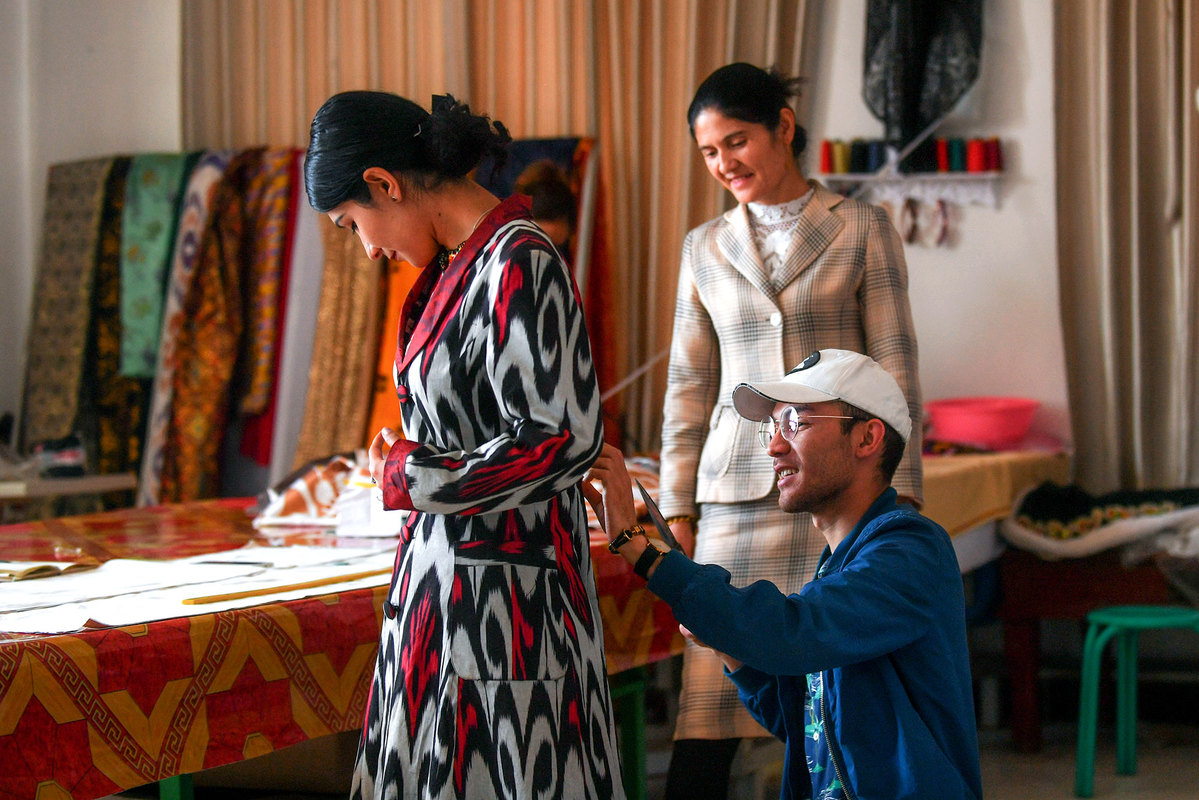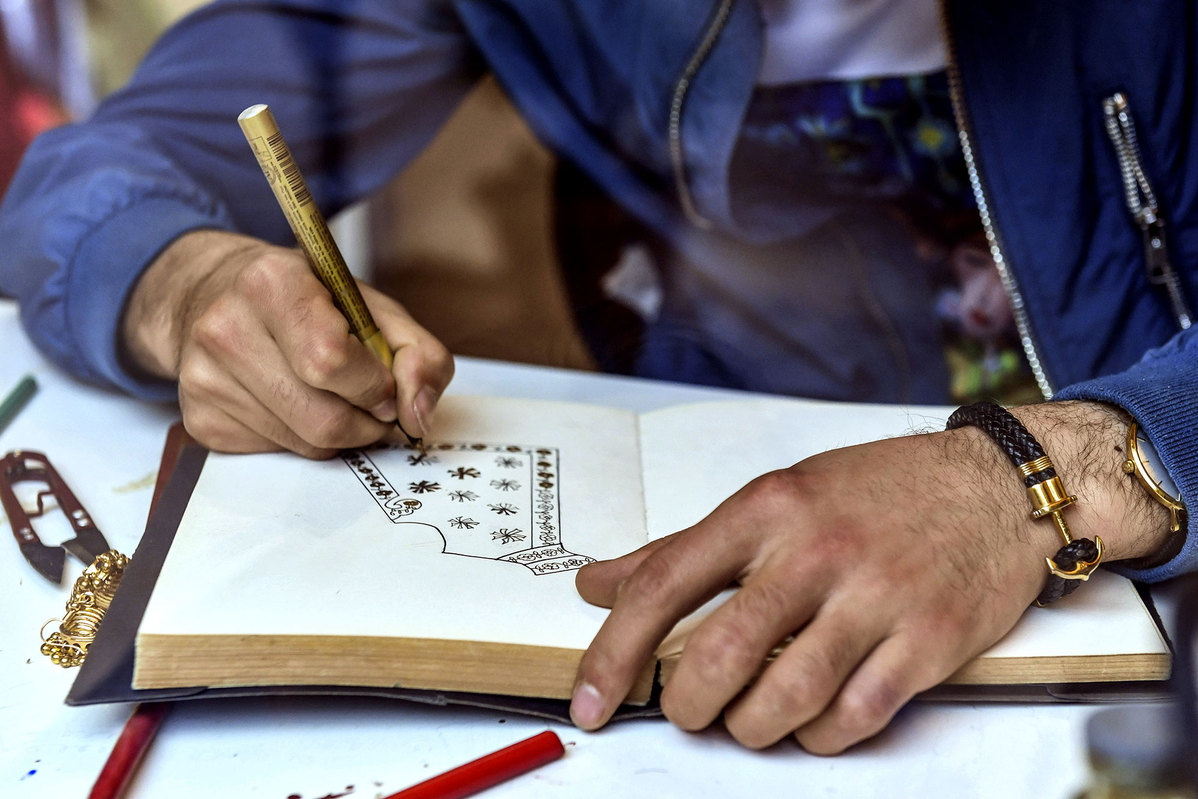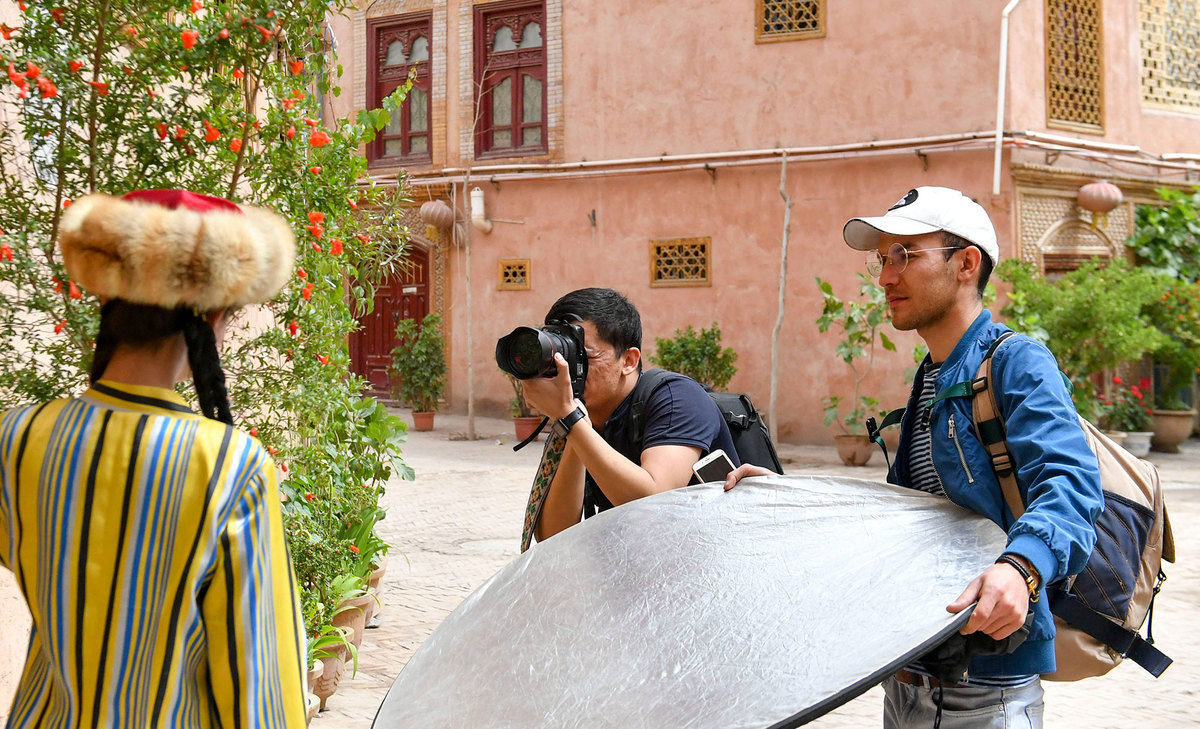Young Uygur designer shows a passion for ethnic fashion

A 26-year-old from the Xinjiang Uygur autonomous region creates new looks based on traditional clothing styles
Editor‘s note: This is the sixth in a series of stories focusing on the Xinjiang Uygur autonomous region, looking at developments in the economy, the cultural and business sectors, and poverty alleviation measures.
Fashions change, but the eye for beauty never does. Mewlan Turaq has never seen Project Runway, a reality television series from the United States that focuses on fashion design, but the 26-year-old designer is weaving his own project to preserve traditional Uygur costumes.
At his boutique in the Old Town of Kashgar, Xinjiang Uygur autonomous region, in China‘s far northwest, Mewlan sketches a dress in the sunlight flooding in through a blue window. When a customer walks in, he immediately puts down his pencil and recommends they try on the various floral headwear, dresses and boots hanging on the walls.
Mewlan‘s store sells and rents both traditional costumes and modern, modified pieces that feature his unique designs. He knows the ins and outs of the fabric and patterns of each piece like the back of his hand.
Since childhood, Mewlan has been obsessed with the traditional ethnic cultures of Xinjiang, which is home to a large number of ethnic groups. He developed his love of making ethnic costumes thanks to his mother Aygul Khasim, a tailor who can make both traditional and modern clothing.
With her help, Mewlan has recreated various costumes that have long enjoyed popularity in Xinjiang. Videos showcasing the costumes have even gone viral on Chinese social media, and that success has given life to his long-held dream - to become a fashion designer.

Evolution
Mewlan has loved designing things since he was a child. But, when his father got sick, he decided to study medicine at college. In 2016, then still a college student, Mewlan joined "I‘m from Xinjiang", a project by renowned Uygur photographer Kurbanjan Samat aimed at recording and promoting Xinjiang‘s various cultures.
Inspired by the popular 100 Years of Beauty video series by the US storytelling company Cut.com, which highlights changes in fashion trends in a country or region over time, Mewlan and his team released their own video in 2017 to look back on trends in Uygur women‘s fashion over the past century.
In the two-minute video, Mewlan illustrated the evolution of Uygur fashion in his hometown from the 1910s to the 2010s.
"We can see that time has left different marks on our clothes, and different cultures have blended," Mewlan said. From his perspective, the cultures of East and West have met and melded in Kashgar, an important trading post on the ancient Silk Road, and that has shown in the evolution of local fashion.
Without any professional training in fashion design or dressmaking, Mewlan asked his mother for help. To reproduce all the costumes, Mewlan and Aygul collected a wealth of historical documents and old photos, and visited many old tailors to gain inspiration.
They spent a whole week making their first costume. The cash-strapped designers had to produce a prototype using cheap fabrics before making the real piece. For a while, Mewlan took a part-time job in a restaurant simply so he could use the printer there to print out all the file photos he found online for free.
In order to find the best jewelry to go with the costumes, he visited jewelry makers shop by shop to spark his imagination. A friend in France saw one of his social media posts asking for information about old Xinjiang jewelry, and later contacted him to say they remembered seeing a pair of old earrings in a pawnshop in Paris.
"A pair of silver earrings like that usually cost 1,000 to 2,000 yuan ($146 to $292), but the pawnbroker insisted on selling them to me at a price of 4,000 yuan, not a penny less," Mewlan said. He had to spend a large part of his savings to get hold of the earrings.
The mother and son spent five months sewing dozens of costumes, which are gracefully showcased by Uygur model Mireay Memet in the video.
In another video, Mewlan recreates different century-old costumes that were popular in Xinjiang‘s cities and prefectures.
"I hope I can show the world the real beauty of traditional costumes," he said. "The pursuit of beauty is a natural and sincere desire of people in all countries and all ethnic groups. The world is changing. China is developing, and so is Xinjiang. A changing society is reflected in local fashion trends."

Potential
The videos ignited Mewlan‘s passion for fashion, pushing him to become a designer after graduation. Hoping he would still become a doctor, his parents strongly opposed his decision. Aygul even refused to help him make more costumes.
But Mewlan carried on, anyway. Having noticed the business potential behind the growing number of tourists to Kashgar, he opened his boutique in October. He rents out all the costumes he and his mother made, along with the jewelry they restored, to tourists who want to experience the old city as locals. He also sells handmade floral caps and purses.
"I hope tourists will not only buy Kashgar souvenirs, but also experience the fashion and cultures of Kashgar. In this old town they can travel in time," he said.
After his grandfather visited the boutique and saw how business was booming, he helped convince Mewlan‘s parents that this career path was the right one.
"Now, they are all supportive of me," the young store owner said. "One of my biggest successes is bringing new breakthroughs to my mother‘s tailoring career."
Aygul now works full-time for her son, as the ambitious designer has taken an increasing number of orders on e-commerce platforms such as Taobao. Mewlan has also hired five poverty-stricken families in rural Kashgar to produce handmade accessories, a move that supports the government‘s nationwide poverty reduction drive.
Without proper training, Mewlan said his inspiration comes from the city itself. When he wanders down winding alleys, the shape of a window, the patterns of a carpet or the wooden carving of an ornament can be his muse.
"The more I get to know about the history of the city, the beautiful stories in it, the more I come to love it," he said.
He spends most of his spare time visiting old tailors and craftsmen, and shopping at flea markets. When researching, he sticks to old books and photos, from which he has drawn the conclusion that clothes can record history and are a language through which different cultures can communicate.
"I care about the cultures, the history and the aesthetic values behind the costumes. More importantly, I would like to see how cultures blend together and what cultures these blended elements come from," he said.
Recently, he‘s been working on modern designs with traditional features to "promote beautiful Xinjiang cultures to more young people in a way they will like", he said, noting that mixing modern and traditional is a good way of passing on cultural heritage.
Mewlan plans to pursue fashion design studies in the future.
"I hope I can come up with more special designs for more people who would like to know about the charms of Xinjiang," he said.










